Review of Research: Acute Care Nursing Practices and Challenges
VerifiedAdded on 2023/01/06
|18
|4838
|32
Literature Review
AI Summary
This literature review synthesizes research on various aspects of acute care nursing. It begins by exploring the nurse-patient relationship, emphasizing its importance in improving patient outcomes and the strategies nurses employ to enhance it. The review then delves into healthcare-associated infections (HAIs), analyzing their prevalence in acute care settings and the implications for patient morbidity and mortality. Furthermore, it examines the challenges and considerations in nursing patients with intellectual disabilities, highlighting the need for experienced nurses and specialized care approaches. The review also touches upon wound care practices and the implementation of evidence-based practices in managing conditions like bronchiolitis. Through the analysis of multiple studies, this review provides a comprehensive overview of key issues and practices in acute care nursing, offering insights into improving patient care and outcomes.

Literature Review
Paraphrase This Document
Need a fresh take? Get an instant paraphrase of this document with our AI Paraphraser
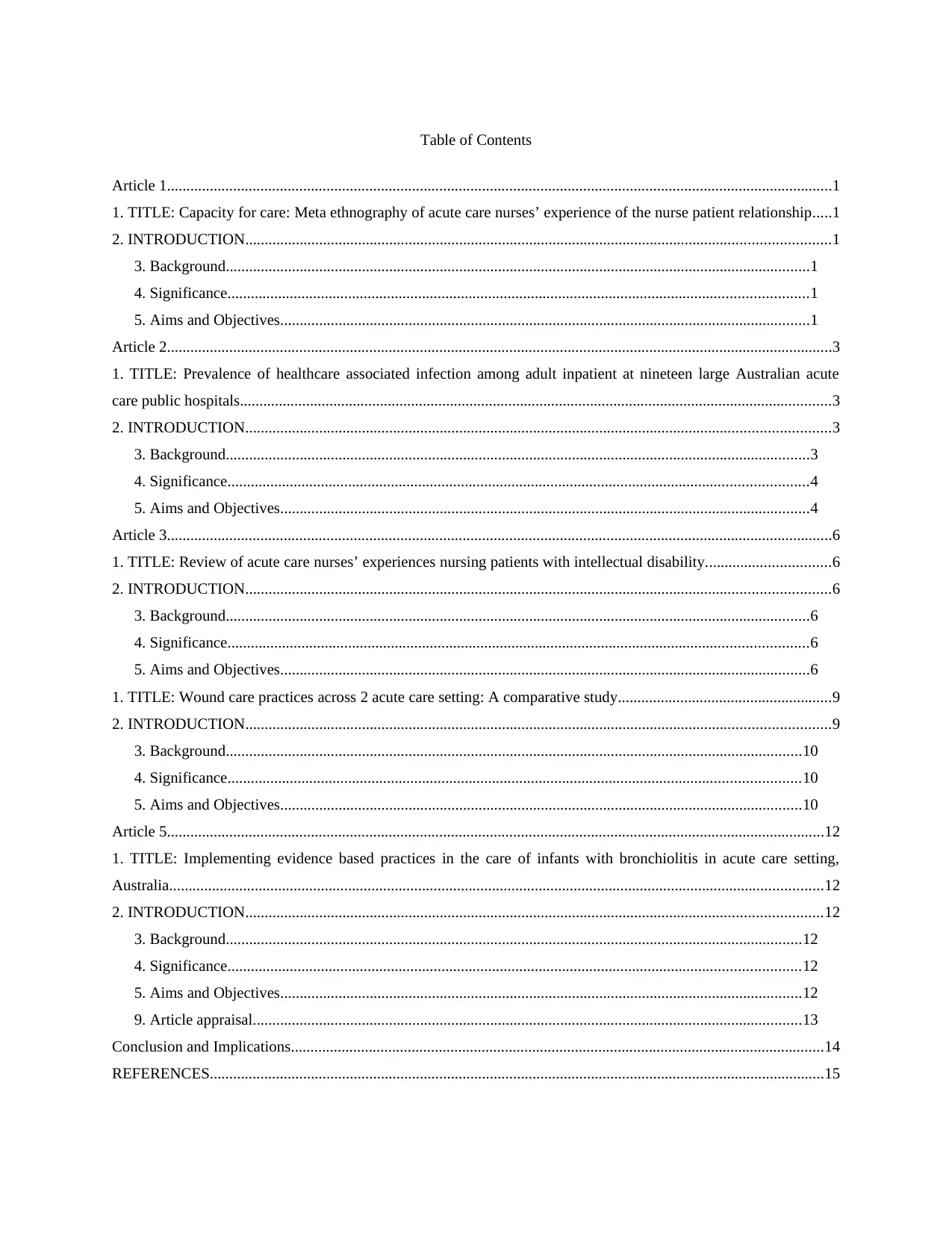
Table of Contents
Article 1...........................................................................................................................................................................1
1. TITLE: Capacity for care: Meta ethnography of acute care nurses’ experience of the nurse patient relationship.....1
2. INTRODUCTION......................................................................................................................................................1
3. Background......................................................................................................................................................1
4. Significance.....................................................................................................................................................1
5. Aims and Objectives........................................................................................................................................1
Article 2...........................................................................................................................................................................3
1. TITLE: Prevalence of healthcare associated infection among adult inpatient at nineteen large Australian acute
care public hospitals........................................................................................................................................................3
2. INTRODUCTION......................................................................................................................................................3
3. Background......................................................................................................................................................3
4. Significance.....................................................................................................................................................4
5. Aims and Objectives........................................................................................................................................4
Article 3...........................................................................................................................................................................6
1. TITLE: Review of acute care nurses’ experiences nursing patients with intellectual disability................................6
2. INTRODUCTION......................................................................................................................................................6
3. Background......................................................................................................................................................6
4. Significance.....................................................................................................................................................6
5. Aims and Objectives........................................................................................................................................6
1. TITLE: Wound care practices across 2 acute care setting: A comparative study.......................................................9
2. INTRODUCTION......................................................................................................................................................9
3. Background....................................................................................................................................................10
4. Significance...................................................................................................................................................10
5. Aims and Objectives......................................................................................................................................10
Article 5.........................................................................................................................................................................12
1. TITLE: Implementing evidence based practices in the care of infants with bronchiolitis in acute care setting,
Australia........................................................................................................................................................................12
2. INTRODUCTION....................................................................................................................................................12
3. Background....................................................................................................................................................12
4. Significance...................................................................................................................................................12
5. Aims and Objectives......................................................................................................................................12
9. Article appraisal.............................................................................................................................................13
Conclusion and Implications.........................................................................................................................................14
REFERENCES..............................................................................................................................................................15
Article 1...........................................................................................................................................................................1
1. TITLE: Capacity for care: Meta ethnography of acute care nurses’ experience of the nurse patient relationship.....1
2. INTRODUCTION......................................................................................................................................................1
3. Background......................................................................................................................................................1
4. Significance.....................................................................................................................................................1
5. Aims and Objectives........................................................................................................................................1
Article 2...........................................................................................................................................................................3
1. TITLE: Prevalence of healthcare associated infection among adult inpatient at nineteen large Australian acute
care public hospitals........................................................................................................................................................3
2. INTRODUCTION......................................................................................................................................................3
3. Background......................................................................................................................................................3
4. Significance.....................................................................................................................................................4
5. Aims and Objectives........................................................................................................................................4
Article 3...........................................................................................................................................................................6
1. TITLE: Review of acute care nurses’ experiences nursing patients with intellectual disability................................6
2. INTRODUCTION......................................................................................................................................................6
3. Background......................................................................................................................................................6
4. Significance.....................................................................................................................................................6
5. Aims and Objectives........................................................................................................................................6
1. TITLE: Wound care practices across 2 acute care setting: A comparative study.......................................................9
2. INTRODUCTION......................................................................................................................................................9
3. Background....................................................................................................................................................10
4. Significance...................................................................................................................................................10
5. Aims and Objectives......................................................................................................................................10
Article 5.........................................................................................................................................................................12
1. TITLE: Implementing evidence based practices in the care of infants with bronchiolitis in acute care setting,
Australia........................................................................................................................................................................12
2. INTRODUCTION....................................................................................................................................................12
3. Background....................................................................................................................................................12
4. Significance...................................................................................................................................................12
5. Aims and Objectives......................................................................................................................................12
9. Article appraisal.............................................................................................................................................13
Conclusion and Implications.........................................................................................................................................14
REFERENCES..............................................................................................................................................................15
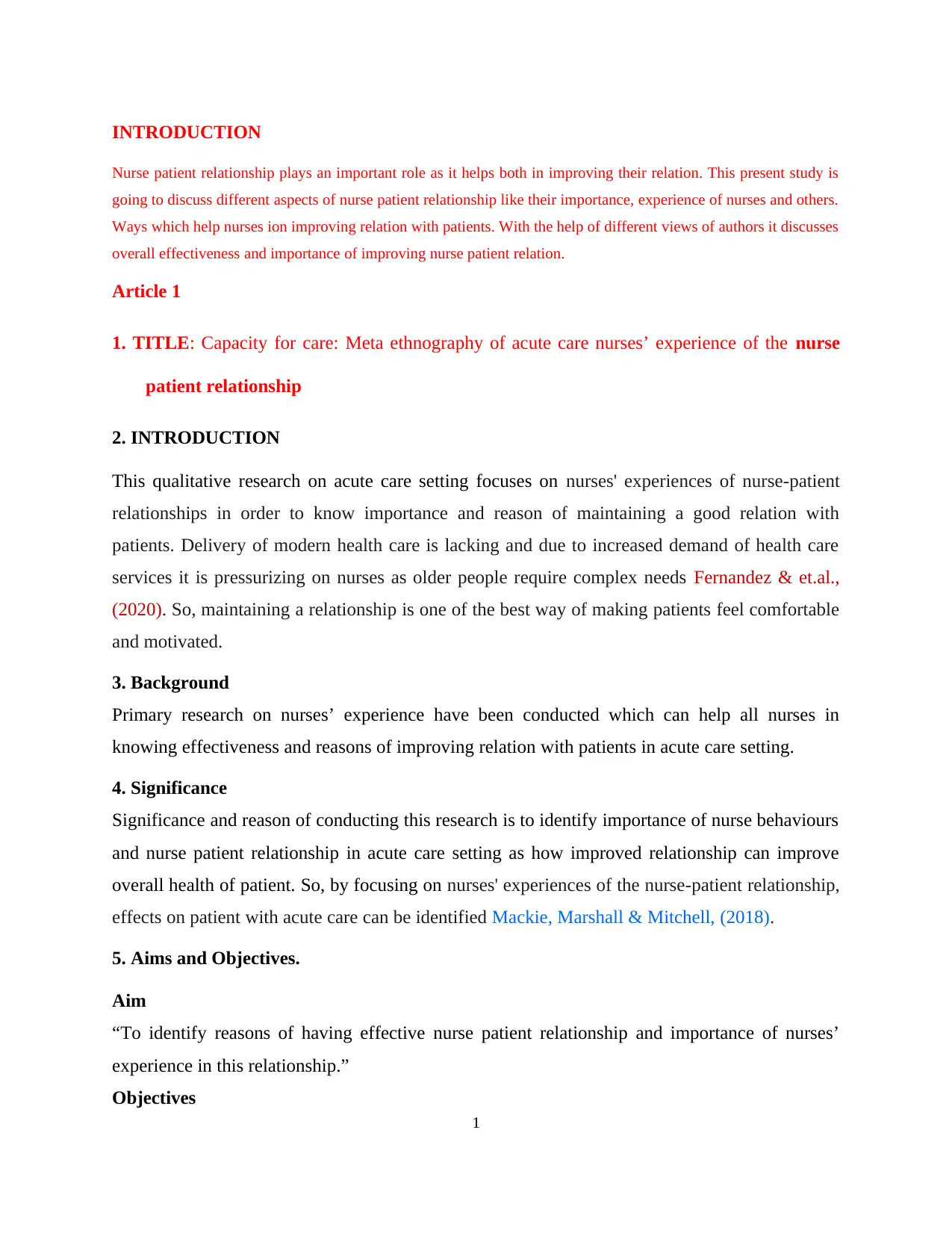
INTRODUCTION
Nurse patient relationship plays an important role as it helps both in improving their relation. This present study is
going to discuss different aspects of nurse patient relationship like their importance, experience of nurses and others.
Ways which help nurses ion improving relation with patients. With the help of different views of authors it discusses
overall effectiveness and importance of improving nurse patient relation.
Article 1
1. TITLE: Capacity for care: Meta ethnography of acute care nurses’ experience of the nurse
patient relationship
2. INTRODUCTION
This qualitative research on acute care setting focuses on nurses' experiences of nurse‐patient
relationships in order to know importance and reason of maintaining a good relation with
patients. Delivery of modern health care is lacking and due to increased demand of health care
services it is pressurizing on nurses as older people require complex needs Fernandez & et.al.,
(2020). So, maintaining a relationship is one of the best way of making patients feel comfortable
and motivated.
3. Background
Primary research on nurses’ experience have been conducted which can help all nurses in
knowing effectiveness and reasons of improving relation with patients in acute care setting.
4. Significance
Significance and reason of conducting this research is to identify importance of nurse behaviours
and nurse patient relationship in acute care setting as how improved relationship can improve
overall health of patient. So, by focusing on nurses' experiences of the nurse‐patient relationship,
effects on patient with acute care can be identified Mackie, Marshall & Mitchell, (2018).
5. Aims and Objectives.
Aim
“To identify reasons of having effective nurse patient relationship and importance of nurses’
experience in this relationship.”
Objectives
1
Nurse patient relationship plays an important role as it helps both in improving their relation. This present study is
going to discuss different aspects of nurse patient relationship like their importance, experience of nurses and others.
Ways which help nurses ion improving relation with patients. With the help of different views of authors it discusses
overall effectiveness and importance of improving nurse patient relation.
Article 1
1. TITLE: Capacity for care: Meta ethnography of acute care nurses’ experience of the nurse
patient relationship
2. INTRODUCTION
This qualitative research on acute care setting focuses on nurses' experiences of nurse‐patient
relationships in order to know importance and reason of maintaining a good relation with
patients. Delivery of modern health care is lacking and due to increased demand of health care
services it is pressurizing on nurses as older people require complex needs Fernandez & et.al.,
(2020). So, maintaining a relationship is one of the best way of making patients feel comfortable
and motivated.
3. Background
Primary research on nurses’ experience have been conducted which can help all nurses in
knowing effectiveness and reasons of improving relation with patients in acute care setting.
4. Significance
Significance and reason of conducting this research is to identify importance of nurse behaviours
and nurse patient relationship in acute care setting as how improved relationship can improve
overall health of patient. So, by focusing on nurses' experiences of the nurse‐patient relationship,
effects on patient with acute care can be identified Mackie, Marshall & Mitchell, (2018).
5. Aims and Objectives.
Aim
“To identify reasons of having effective nurse patient relationship and importance of nurses’
experience in this relationship.”
Objectives
1
⊘ This is a preview!⊘
Do you want full access?
Subscribe today to unlock all pages.

Trusted by 1+ million students worldwide
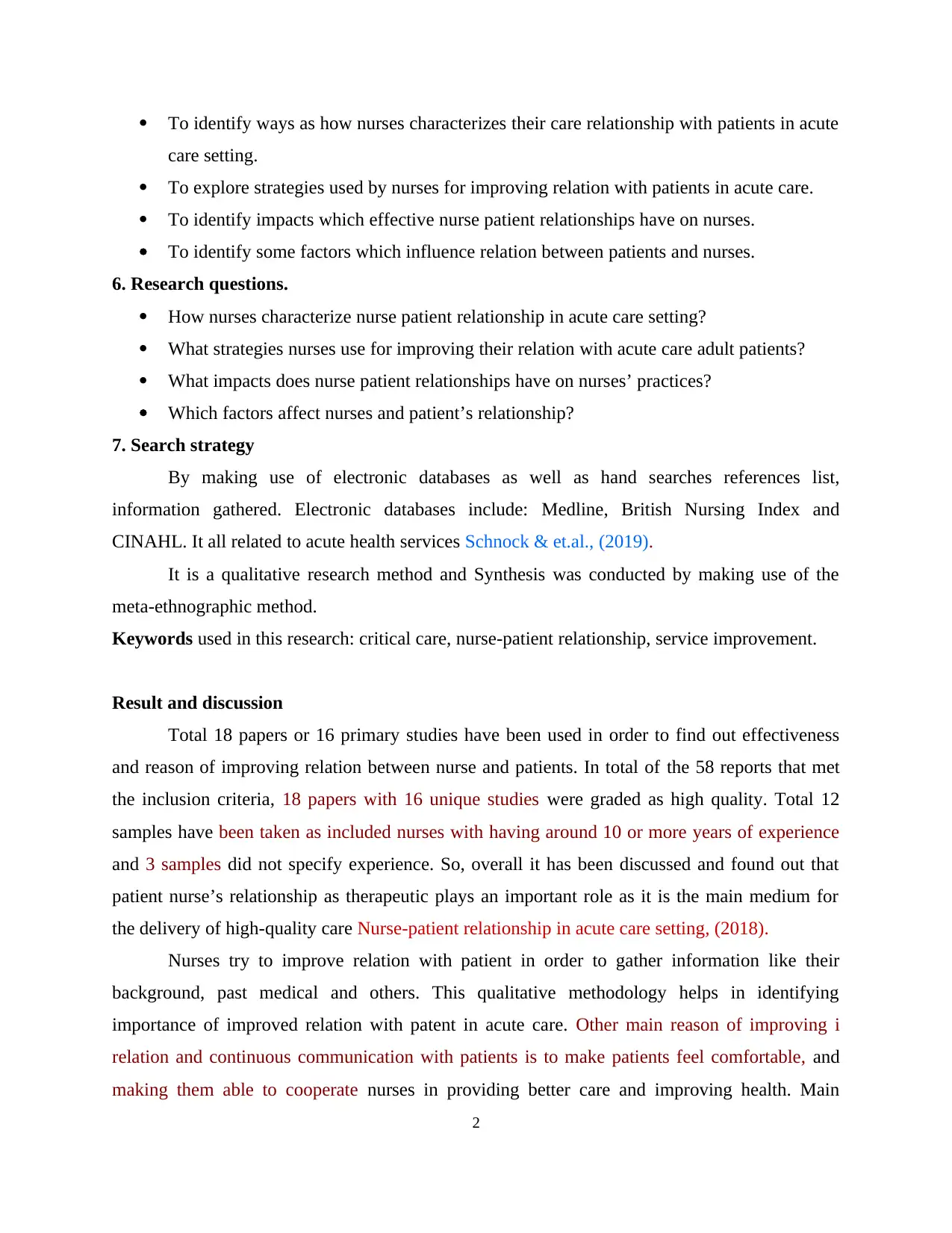
To identify ways as how nurses characterizes their care relationship with patients in acute
care setting.
To explore strategies used by nurses for improving relation with patients in acute care.
To identify impacts which effective nurse patient relationships have on nurses.
To identify some factors which influence relation between patients and nurses.
6. Research questions.
How nurses characterize nurse patient relationship in acute care setting?
What strategies nurses use for improving their relation with acute care adult patients?
What impacts does nurse patient relationships have on nurses’ practices?
Which factors affect nurses and patient’s relationship?
7. Search strategy
By making use of electronic databases as well as hand searches references list,
information gathered. Electronic databases include: Medline, British Nursing Index and
CINAHL. It all related to acute health services Schnock & et.al., (2019).
It is a qualitative research method and Synthesis was conducted by making use of the
meta‐ethnographic method.
Keywords used in this research: critical care, nurse-patient relationship, service improvement.
Result and discussion
Total 18 papers or 16 primary studies have been used in order to find out effectiveness
and reason of improving relation between nurse and patients. In total of the 58 reports that met
the inclusion criteria, 18 papers with 16 unique studies were graded as high quality. Total 12
samples have been taken as included nurses with having around 10 or more years of experience
and 3 samples did not specify experience. So, overall it has been discussed and found out that
patient nurse’s relationship as therapeutic plays an important role as it is the main medium for
the delivery of high‐quality care Nurse‐patient relationship in acute care setting, (2018).
Nurses try to improve relation with patient in order to gather information like their
background, past medical and others. This qualitative methodology helps in identifying
importance of improved relation with patent in acute care. Other main reason of improving i
relation and continuous communication with patients is to make patients feel comfortable, and
making them able to cooperate nurses in providing better care and improving health. Main
2
care setting.
To explore strategies used by nurses for improving relation with patients in acute care.
To identify impacts which effective nurse patient relationships have on nurses.
To identify some factors which influence relation between patients and nurses.
6. Research questions.
How nurses characterize nurse patient relationship in acute care setting?
What strategies nurses use for improving their relation with acute care adult patients?
What impacts does nurse patient relationships have on nurses’ practices?
Which factors affect nurses and patient’s relationship?
7. Search strategy
By making use of electronic databases as well as hand searches references list,
information gathered. Electronic databases include: Medline, British Nursing Index and
CINAHL. It all related to acute health services Schnock & et.al., (2019).
It is a qualitative research method and Synthesis was conducted by making use of the
meta‐ethnographic method.
Keywords used in this research: critical care, nurse-patient relationship, service improvement.
Result and discussion
Total 18 papers or 16 primary studies have been used in order to find out effectiveness
and reason of improving relation between nurse and patients. In total of the 58 reports that met
the inclusion criteria, 18 papers with 16 unique studies were graded as high quality. Total 12
samples have been taken as included nurses with having around 10 or more years of experience
and 3 samples did not specify experience. So, overall it has been discussed and found out that
patient nurse’s relationship as therapeutic plays an important role as it is the main medium for
the delivery of high‐quality care Nurse‐patient relationship in acute care setting, (2018).
Nurses try to improve relation with patient in order to gather information like their
background, past medical and others. This qualitative methodology helps in identifying
importance of improved relation with patent in acute care. Other main reason of improving i
relation and continuous communication with patients is to make patients feel comfortable, and
making them able to cooperate nurses in providing better care and improving health. Main
2
Paraphrase This Document
Need a fresh take? Get an instant paraphrase of this document with our AI Paraphraser
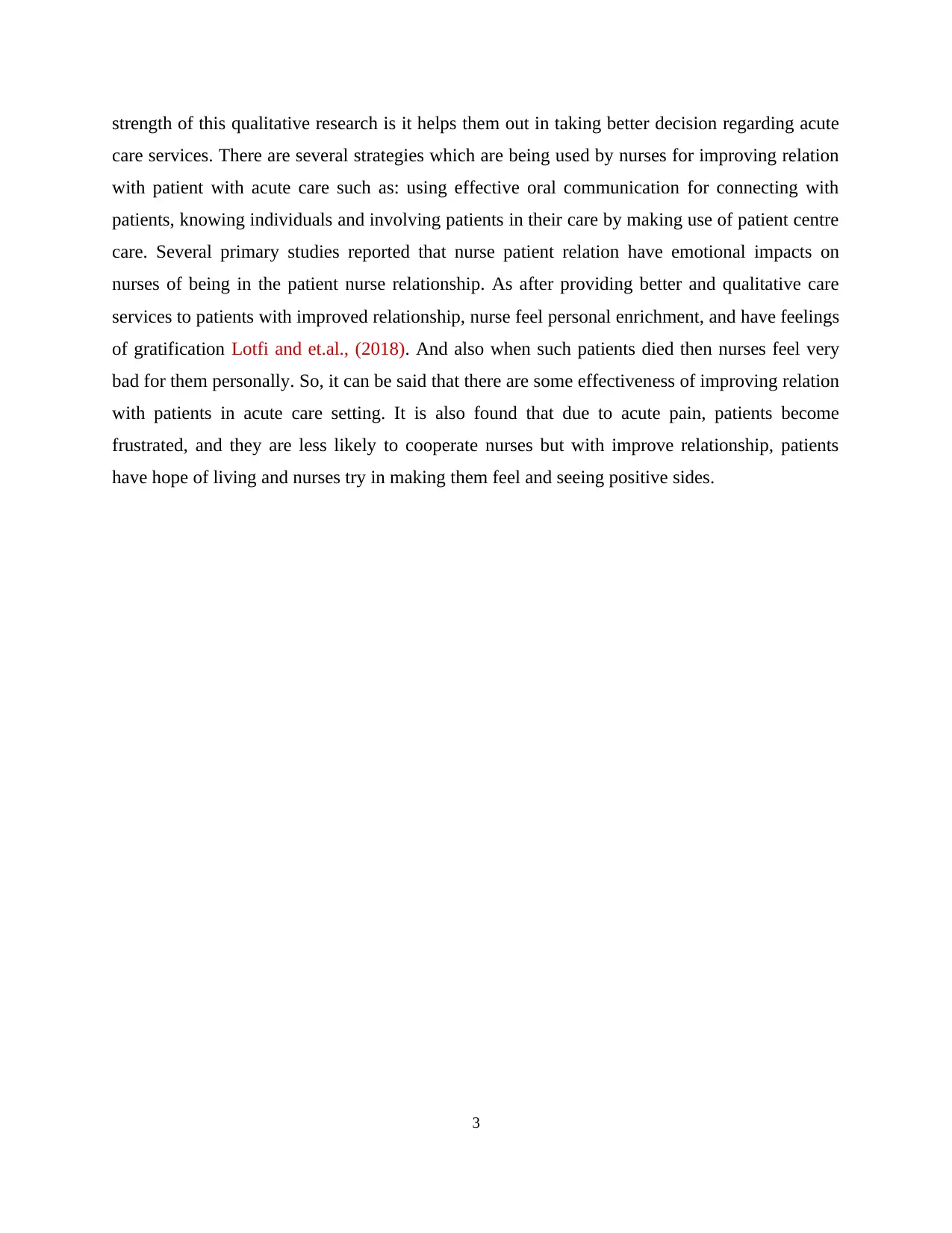
strength of this qualitative research is it helps them out in taking better decision regarding acute
care services. There are several strategies which are being used by nurses for improving relation
with patient with acute care such as: using effective oral communication for connecting with
patients, knowing individuals and involving patients in their care by making use of patient centre
care. Several primary studies reported that nurse patient relation have emotional impacts on
nurses of being in the patient nurse relationship. As after providing better and qualitative care
services to patients with improved relationship, nurse feel personal enrichment, and have feelings
of gratification Lotfi and et.al., (2018). And also when such patients died then nurses feel very
bad for them personally. So, it can be said that there are some effectiveness of improving relation
with patients in acute care setting. It is also found that due to acute pain, patients become
frustrated, and they are less likely to cooperate nurses but with improve relationship, patients
have hope of living and nurses try in making them feel and seeing positive sides.
3
care services. There are several strategies which are being used by nurses for improving relation
with patient with acute care such as: using effective oral communication for connecting with
patients, knowing individuals and involving patients in their care by making use of patient centre
care. Several primary studies reported that nurse patient relation have emotional impacts on
nurses of being in the patient nurse relationship. As after providing better and qualitative care
services to patients with improved relationship, nurse feel personal enrichment, and have feelings
of gratification Lotfi and et.al., (2018). And also when such patients died then nurses feel very
bad for them personally. So, it can be said that there are some effectiveness of improving relation
with patients in acute care setting. It is also found that due to acute pain, patients become
frustrated, and they are less likely to cooperate nurses but with improve relationship, patients
have hope of living and nurses try in making them feel and seeing positive sides.
3
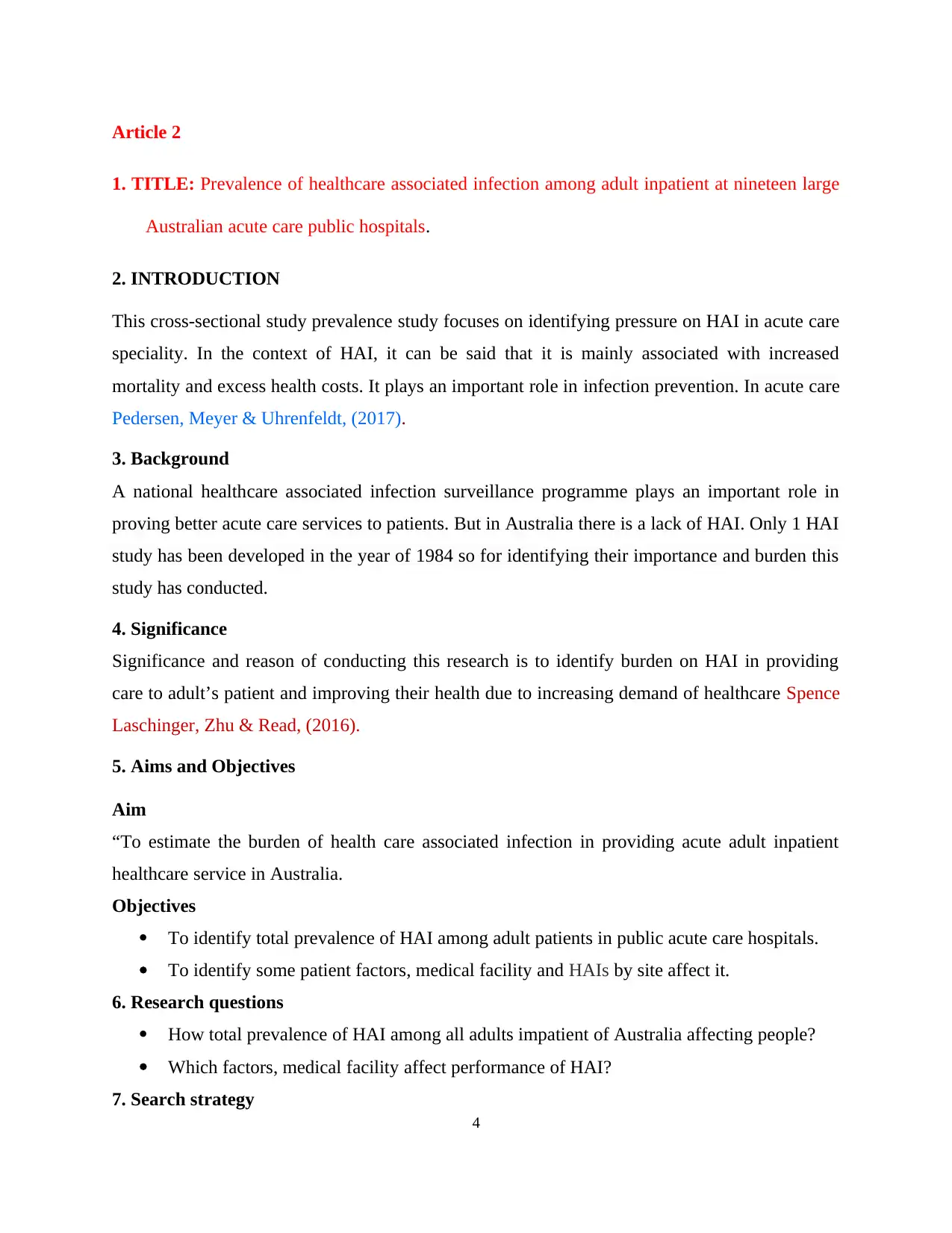
Article 2
1. TITLE: Prevalence of healthcare associated infection among adult inpatient at nineteen large
Australian acute care public hospitals.
2. INTRODUCTION
This cross-sectional study prevalence study focuses on identifying pressure on HAI in acute care
speciality. In the context of HAI, it can be said that it is mainly associated with increased
mortality and excess health costs. It plays an important role in infection prevention. In acute care
Pedersen, Meyer & Uhrenfeldt, (2017).
3. Background
A national healthcare associated infection surveillance programme plays an important role in
proving better acute care services to patients. But in Australia there is a lack of HAI. Only 1 HAI
study has been developed in the year of 1984 so for identifying their importance and burden this
study has conducted.
4. Significance
Significance and reason of conducting this research is to identify burden on HAI in providing
care to adult’s patient and improving their health due to increasing demand of healthcare Spence
Laschinger, Zhu & Read, (2016).
5. Aims and Objectives
Aim
“To estimate the burden of health care associated infection in providing acute adult inpatient
healthcare service in Australia.
Objectives
To identify total prevalence of HAI among adult patients in public acute care hospitals.
To identify some patient factors, medical facility and HAIs by site affect it.
6. Research questions
How total prevalence of HAI among all adults impatient of Australia affecting people?
Which factors, medical facility affect performance of HAI?
7. Search strategy
4
1. TITLE: Prevalence of healthcare associated infection among adult inpatient at nineteen large
Australian acute care public hospitals.
2. INTRODUCTION
This cross-sectional study prevalence study focuses on identifying pressure on HAI in acute care
speciality. In the context of HAI, it can be said that it is mainly associated with increased
mortality and excess health costs. It plays an important role in infection prevention. In acute care
Pedersen, Meyer & Uhrenfeldt, (2017).
3. Background
A national healthcare associated infection surveillance programme plays an important role in
proving better acute care services to patients. But in Australia there is a lack of HAI. Only 1 HAI
study has been developed in the year of 1984 so for identifying their importance and burden this
study has conducted.
4. Significance
Significance and reason of conducting this research is to identify burden on HAI in providing
care to adult’s patient and improving their health due to increasing demand of healthcare Spence
Laschinger, Zhu & Read, (2016).
5. Aims and Objectives
Aim
“To estimate the burden of health care associated infection in providing acute adult inpatient
healthcare service in Australia.
Objectives
To identify total prevalence of HAI among adult patients in public acute care hospitals.
To identify some patient factors, medical facility and HAIs by site affect it.
6. Research questions
How total prevalence of HAI among all adults impatient of Australia affecting people?
Which factors, medical facility affect performance of HAI?
7. Search strategy
4
⊘ This is a preview!⊘
Do you want full access?
Subscribe today to unlock all pages.

Trusted by 1+ million students worldwide
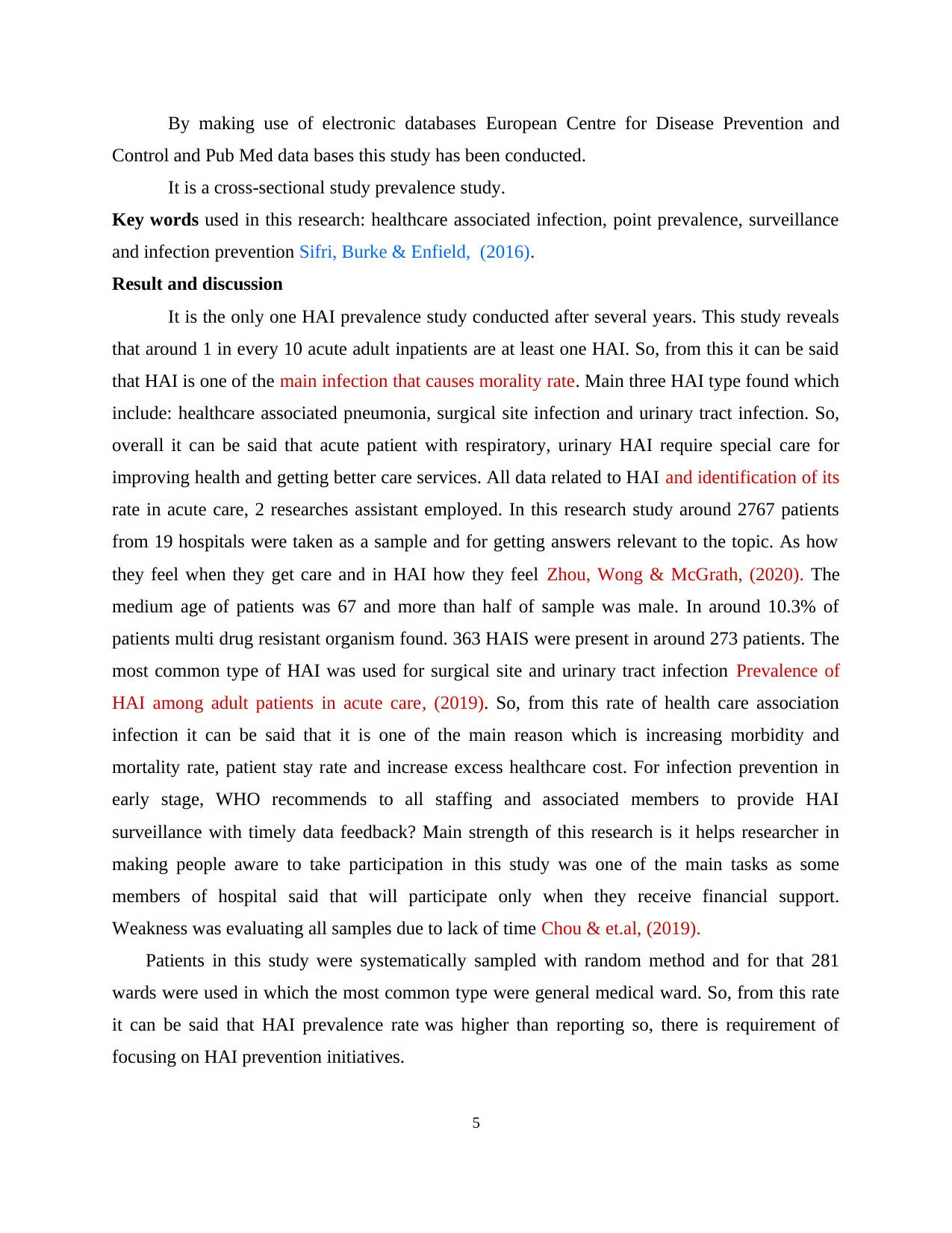
By making use of electronic databases European Centre for Disease Prevention and
Control and Pub Med data bases this study has been conducted.
It is a cross-sectional study prevalence study.
Key words used in this research: healthcare associated infection, point prevalence, surveillance
and infection prevention Sifri, Burke & Enfield, (2016).
Result and discussion
It is the only one HAI prevalence study conducted after several years. This study reveals
that around 1 in every 10 acute adult inpatients are at least one HAI. So, from this it can be said
that HAI is one of the main infection that causes morality rate. Main three HAI type found which
include: healthcare associated pneumonia, surgical site infection and urinary tract infection. So,
overall it can be said that acute patient with respiratory, urinary HAI require special care for
improving health and getting better care services. All data related to HAI and identification of its
rate in acute care, 2 researches assistant employed. In this research study around 2767 patients
from 19 hospitals were taken as a sample and for getting answers relevant to the topic. As how
they feel when they get care and in HAI how they feel Zhou, Wong & McGrath, (2020). The
medium age of patients was 67 and more than half of sample was male. In around 10.3% of
patients multi drug resistant organism found. 363 HAIS were present in around 273 patients. The
most common type of HAI was used for surgical site and urinary tract infection Prevalence of
HAI among adult patients in acute care, (2019). So, from this rate of health care association
infection it can be said that it is one of the main reason which is increasing morbidity and
mortality rate, patient stay rate and increase excess healthcare cost. For infection prevention in
early stage, WHO recommends to all staffing and associated members to provide HAI
surveillance with timely data feedback? Main strength of this research is it helps researcher in
making people aware to take participation in this study was one of the main tasks as some
members of hospital said that will participate only when they receive financial support.
Weakness was evaluating all samples due to lack of time Chou & et.al, (2019).
Patients in this study were systematically sampled with random method and for that 281
wards were used in which the most common type were general medical ward. So, from this rate
it can be said that HAI prevalence rate was higher than reporting so, there is requirement of
focusing on HAI prevention initiatives.
5
Control and Pub Med data bases this study has been conducted.
It is a cross-sectional study prevalence study.
Key words used in this research: healthcare associated infection, point prevalence, surveillance
and infection prevention Sifri, Burke & Enfield, (2016).
Result and discussion
It is the only one HAI prevalence study conducted after several years. This study reveals
that around 1 in every 10 acute adult inpatients are at least one HAI. So, from this it can be said
that HAI is one of the main infection that causes morality rate. Main three HAI type found which
include: healthcare associated pneumonia, surgical site infection and urinary tract infection. So,
overall it can be said that acute patient with respiratory, urinary HAI require special care for
improving health and getting better care services. All data related to HAI and identification of its
rate in acute care, 2 researches assistant employed. In this research study around 2767 patients
from 19 hospitals were taken as a sample and for getting answers relevant to the topic. As how
they feel when they get care and in HAI how they feel Zhou, Wong & McGrath, (2020). The
medium age of patients was 67 and more than half of sample was male. In around 10.3% of
patients multi drug resistant organism found. 363 HAIS were present in around 273 patients. The
most common type of HAI was used for surgical site and urinary tract infection Prevalence of
HAI among adult patients in acute care, (2019). So, from this rate of health care association
infection it can be said that it is one of the main reason which is increasing morbidity and
mortality rate, patient stay rate and increase excess healthcare cost. For infection prevention in
early stage, WHO recommends to all staffing and associated members to provide HAI
surveillance with timely data feedback? Main strength of this research is it helps researcher in
making people aware to take participation in this study was one of the main tasks as some
members of hospital said that will participate only when they receive financial support.
Weakness was evaluating all samples due to lack of time Chou & et.al, (2019).
Patients in this study were systematically sampled with random method and for that 281
wards were used in which the most common type were general medical ward. So, from this rate
it can be said that HAI prevalence rate was higher than reporting so, there is requirement of
focusing on HAI prevention initiatives.
5
Paraphrase This Document
Need a fresh take? Get an instant paraphrase of this document with our AI Paraphraser
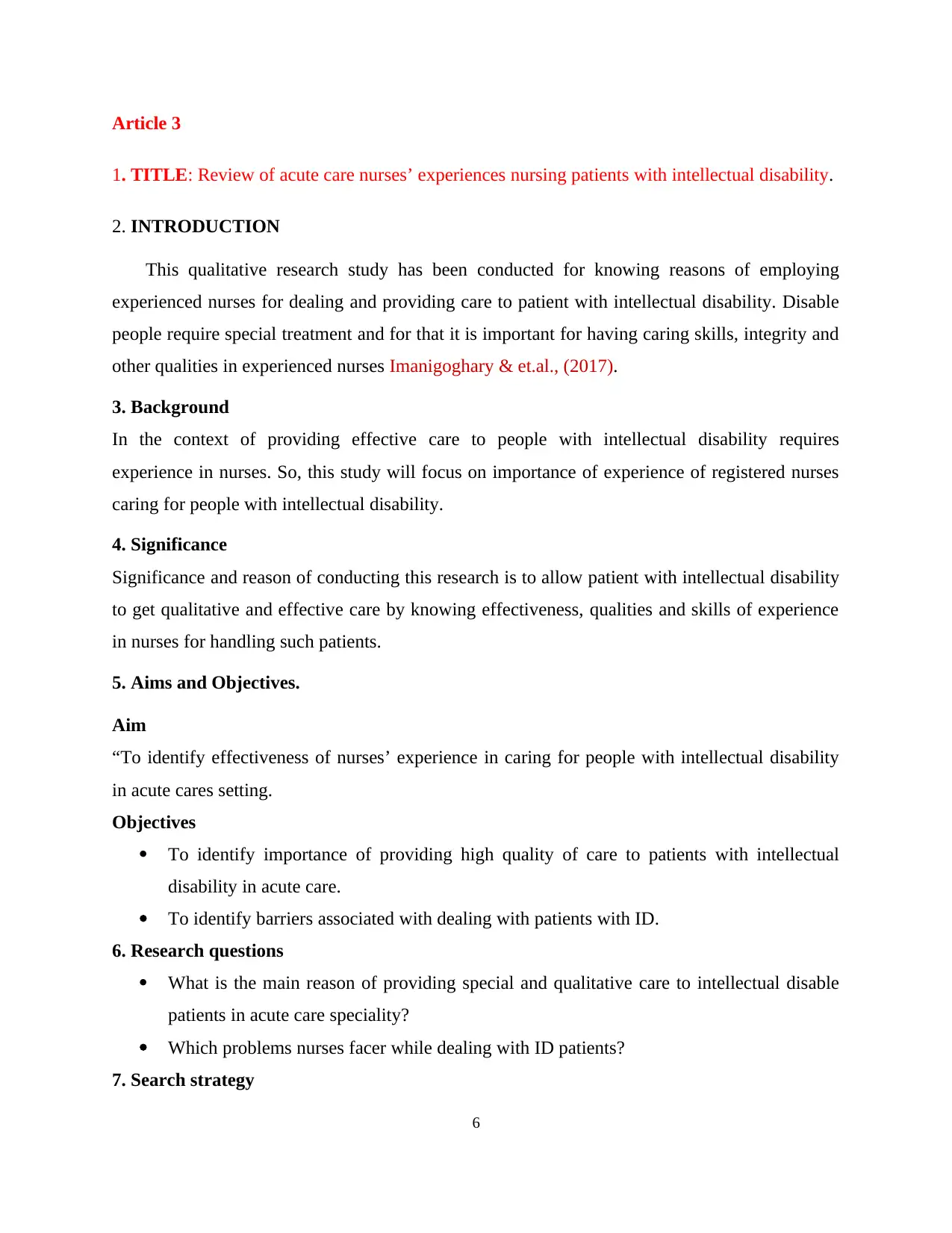
Article 3
1. TITLE: Review of acute care nurses’ experiences nursing patients with intellectual disability.
2. INTRODUCTION
This qualitative research study has been conducted for knowing reasons of employing
experienced nurses for dealing and providing care to patient with intellectual disability. Disable
people require special treatment and for that it is important for having caring skills, integrity and
other qualities in experienced nurses Imanigoghary & et.al., (2017).
3. Background
In the context of providing effective care to people with intellectual disability requires
experience in nurses. So, this study will focus on importance of experience of registered nurses
caring for people with intellectual disability.
4. Significance
Significance and reason of conducting this research is to allow patient with intellectual disability
to get qualitative and effective care by knowing effectiveness, qualities and skills of experience
in nurses for handling such patients.
5. Aims and Objectives.
Aim
“To identify effectiveness of nurses’ experience in caring for people with intellectual disability
in acute cares setting.
Objectives
To identify importance of providing high quality of care to patients with intellectual
disability in acute care.
To identify barriers associated with dealing with patients with ID.
6. Research questions
What is the main reason of providing special and qualitative care to intellectual disable
patients in acute care speciality?
Which problems nurses facer while dealing with ID patients?
7. Search strategy
6
1. TITLE: Review of acute care nurses’ experiences nursing patients with intellectual disability.
2. INTRODUCTION
This qualitative research study has been conducted for knowing reasons of employing
experienced nurses for dealing and providing care to patient with intellectual disability. Disable
people require special treatment and for that it is important for having caring skills, integrity and
other qualities in experienced nurses Imanigoghary & et.al., (2017).
3. Background
In the context of providing effective care to people with intellectual disability requires
experience in nurses. So, this study will focus on importance of experience of registered nurses
caring for people with intellectual disability.
4. Significance
Significance and reason of conducting this research is to allow patient with intellectual disability
to get qualitative and effective care by knowing effectiveness, qualities and skills of experience
in nurses for handling such patients.
5. Aims and Objectives.
Aim
“To identify effectiveness of nurses’ experience in caring for people with intellectual disability
in acute cares setting.
Objectives
To identify importance of providing high quality of care to patients with intellectual
disability in acute care.
To identify barriers associated with dealing with patients with ID.
6. Research questions
What is the main reason of providing special and qualitative care to intellectual disable
patients in acute care speciality?
Which problems nurses facer while dealing with ID patients?
7. Search strategy
6
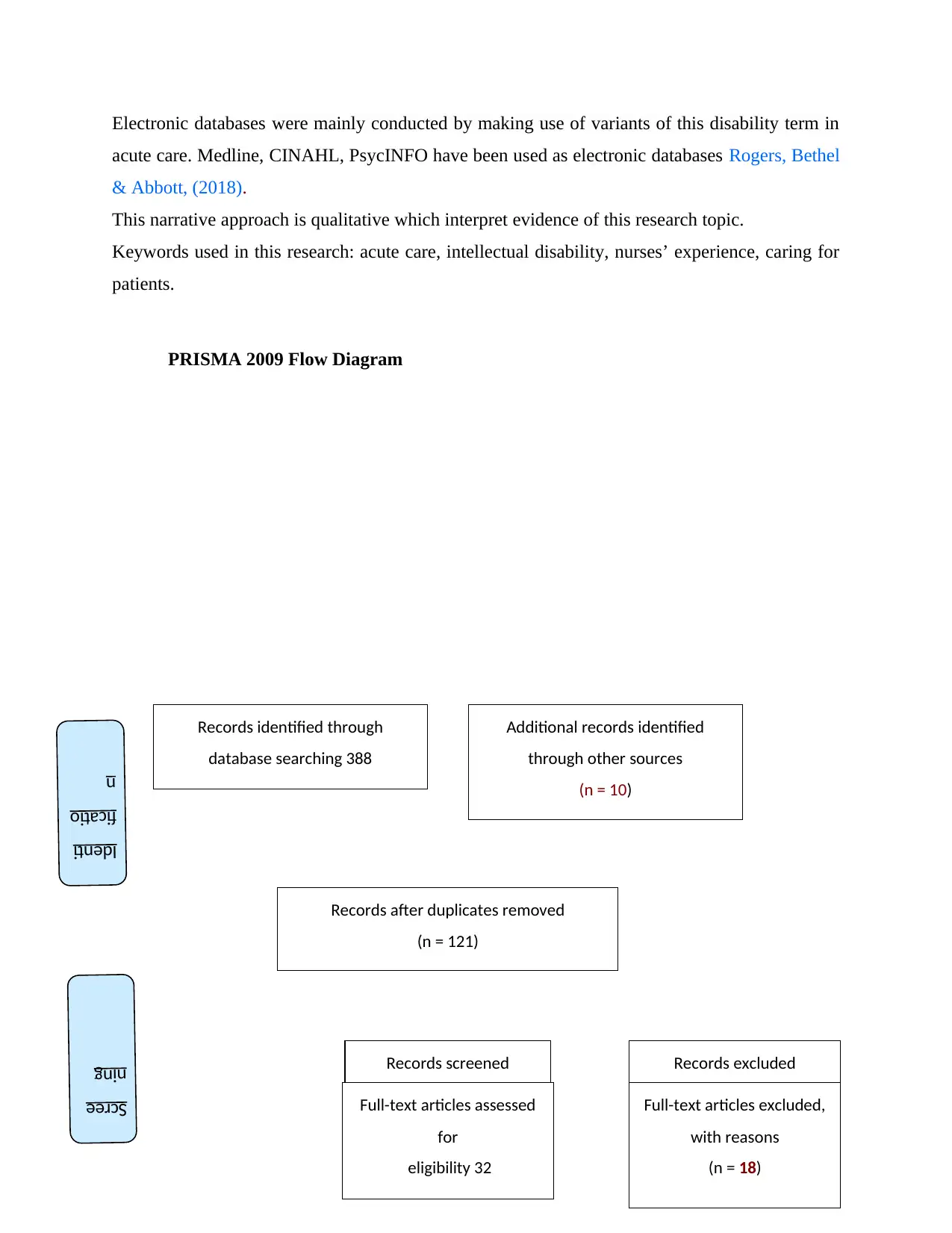
Electronic databases were mainly conducted by making use of variants of this disability term in
acute care. Medline, CINAHL, PsycINFO have been used as electronic databases Rogers, Bethel
& Abbott, (2018).
This narrative approach is qualitative which interpret evidence of this research topic.
Keywords used in this research: acute care, intellectual disability, nurses’ experience, caring for
patients.
PRISMA 2009 Flow Diagram
7
Records identified through
database searching 388
(n = )
Scree
ning
Identi
ficatio
n
Additional records identified
through other sources
(n = 10)
Records after duplicates removed
(n = 121)
Records screened
(n =267)
Records excluded
(n = 235)
Full-text articles assessed
for
eligibility 32
(n = )
Full-text articles excluded,
with reasons
(n = 18)
acute care. Medline, CINAHL, PsycINFO have been used as electronic databases Rogers, Bethel
& Abbott, (2018).
This narrative approach is qualitative which interpret evidence of this research topic.
Keywords used in this research: acute care, intellectual disability, nurses’ experience, caring for
patients.
PRISMA 2009 Flow Diagram
7
Records identified through
database searching 388
(n = )
Scree
ning
Identi
ficatio
n
Additional records identified
through other sources
(n = 10)
Records after duplicates removed
(n = 121)
Records screened
(n =267)
Records excluded
(n = 235)
Full-text articles assessed
for
eligibility 32
(n = )
Full-text articles excluded,
with reasons
(n = 18)
⊘ This is a preview!⊘
Do you want full access?
Subscribe today to unlock all pages.

Trusted by 1+ million students worldwide
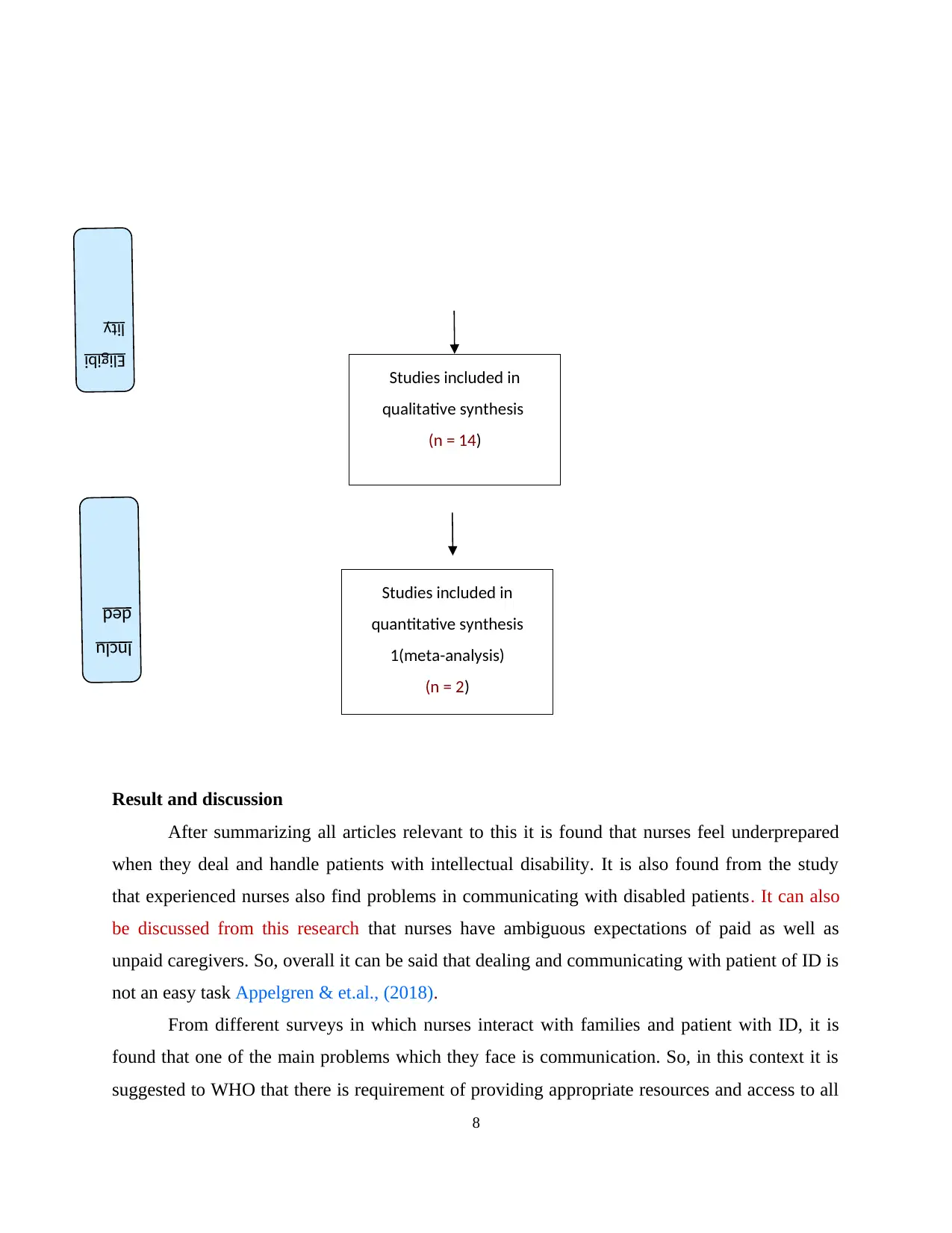
Result and discussion
After summarizing all articles relevant to this it is found that nurses feel underprepared
when they deal and handle patients with intellectual disability. It is also found from the study
that experienced nurses also find problems in communicating with disabled patients. It can also
be discussed from this research that nurses have ambiguous expectations of paid as well as
unpaid caregivers. So, overall it can be said that dealing and communicating with patient of ID is
not an easy task Appelgren & et.al., (2018).
From different surveys in which nurses interact with families and patient with ID, it is
found that one of the main problems which they face is communication. So, in this context it is
suggested to WHO that there is requirement of providing appropriate resources and access to all
8
Inclu
ded
Eligibi
lity
Studies included in
qualitative synthesis
(n = 14)
Studies included in
quantitative synthesis
1(meta-analysis)
(n = 2)
After summarizing all articles relevant to this it is found that nurses feel underprepared
when they deal and handle patients with intellectual disability. It is also found from the study
that experienced nurses also find problems in communicating with disabled patients. It can also
be discussed from this research that nurses have ambiguous expectations of paid as well as
unpaid caregivers. So, overall it can be said that dealing and communicating with patient of ID is
not an easy task Appelgren & et.al., (2018).
From different surveys in which nurses interact with families and patient with ID, it is
found that one of the main problems which they face is communication. So, in this context it is
suggested to WHO that there is requirement of providing appropriate resources and access to all
8
Inclu
ded
Eligibi
lity
Studies included in
qualitative synthesis
(n = 14)
Studies included in
quantitative synthesis
1(meta-analysis)
(n = 2)
Paraphrase This Document
Need a fresh take? Get an instant paraphrase of this document with our AI Paraphraser
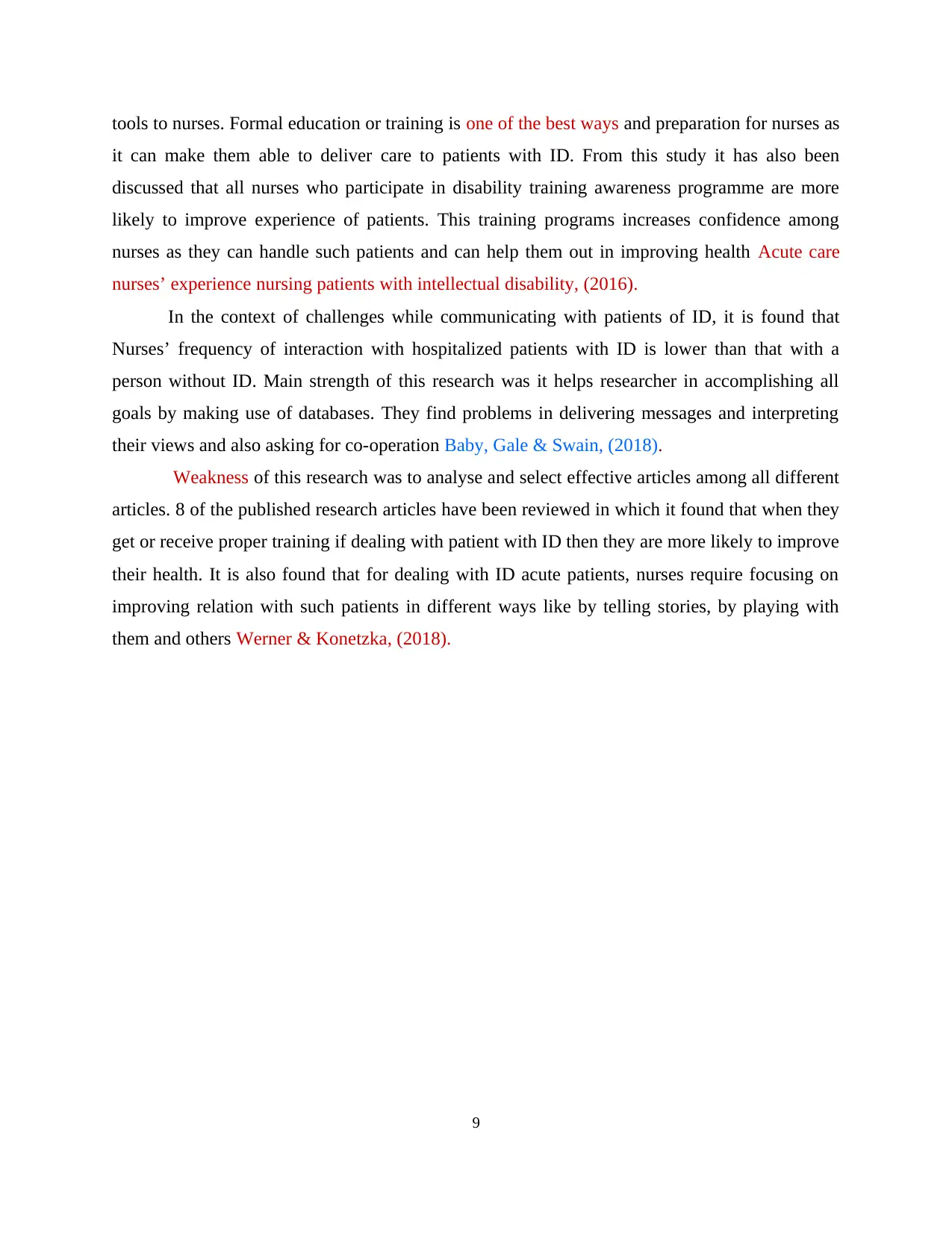
tools to nurses. Formal education or training is one of the best ways and preparation for nurses as
it can make them able to deliver care to patients with ID. From this study it has also been
discussed that all nurses who participate in disability training awareness programme are more
likely to improve experience of patients. This training programs increases confidence among
nurses as they can handle such patients and can help them out in improving health Acute care
nurses’ experience nursing patients with intellectual disability, (2016).
In the context of challenges while communicating with patients of ID, it is found that
Nurses’ frequency of interaction with hospitalized patients with ID is lower than that with a
person without ID. Main strength of this research was it helps researcher in accomplishing all
goals by making use of databases. They find problems in delivering messages and interpreting
their views and also asking for co-operation Baby, Gale & Swain, (2018).
Weakness of this research was to analyse and select effective articles among all different
articles. 8 of the published research articles have been reviewed in which it found that when they
get or receive proper training if dealing with patient with ID then they are more likely to improve
their health. It is also found that for dealing with ID acute patients, nurses require focusing on
improving relation with such patients in different ways like by telling stories, by playing with
them and others Werner & Konetzka, (2018).
9
it can make them able to deliver care to patients with ID. From this study it has also been
discussed that all nurses who participate in disability training awareness programme are more
likely to improve experience of patients. This training programs increases confidence among
nurses as they can handle such patients and can help them out in improving health Acute care
nurses’ experience nursing patients with intellectual disability, (2016).
In the context of challenges while communicating with patients of ID, it is found that
Nurses’ frequency of interaction with hospitalized patients with ID is lower than that with a
person without ID. Main strength of this research was it helps researcher in accomplishing all
goals by making use of databases. They find problems in delivering messages and interpreting
their views and also asking for co-operation Baby, Gale & Swain, (2018).
Weakness of this research was to analyse and select effective articles among all different
articles. 8 of the published research articles have been reviewed in which it found that when they
get or receive proper training if dealing with patient with ID then they are more likely to improve
their health. It is also found that for dealing with ID acute patients, nurses require focusing on
improving relation with such patients in different ways like by telling stories, by playing with
them and others Werner & Konetzka, (2018).
9
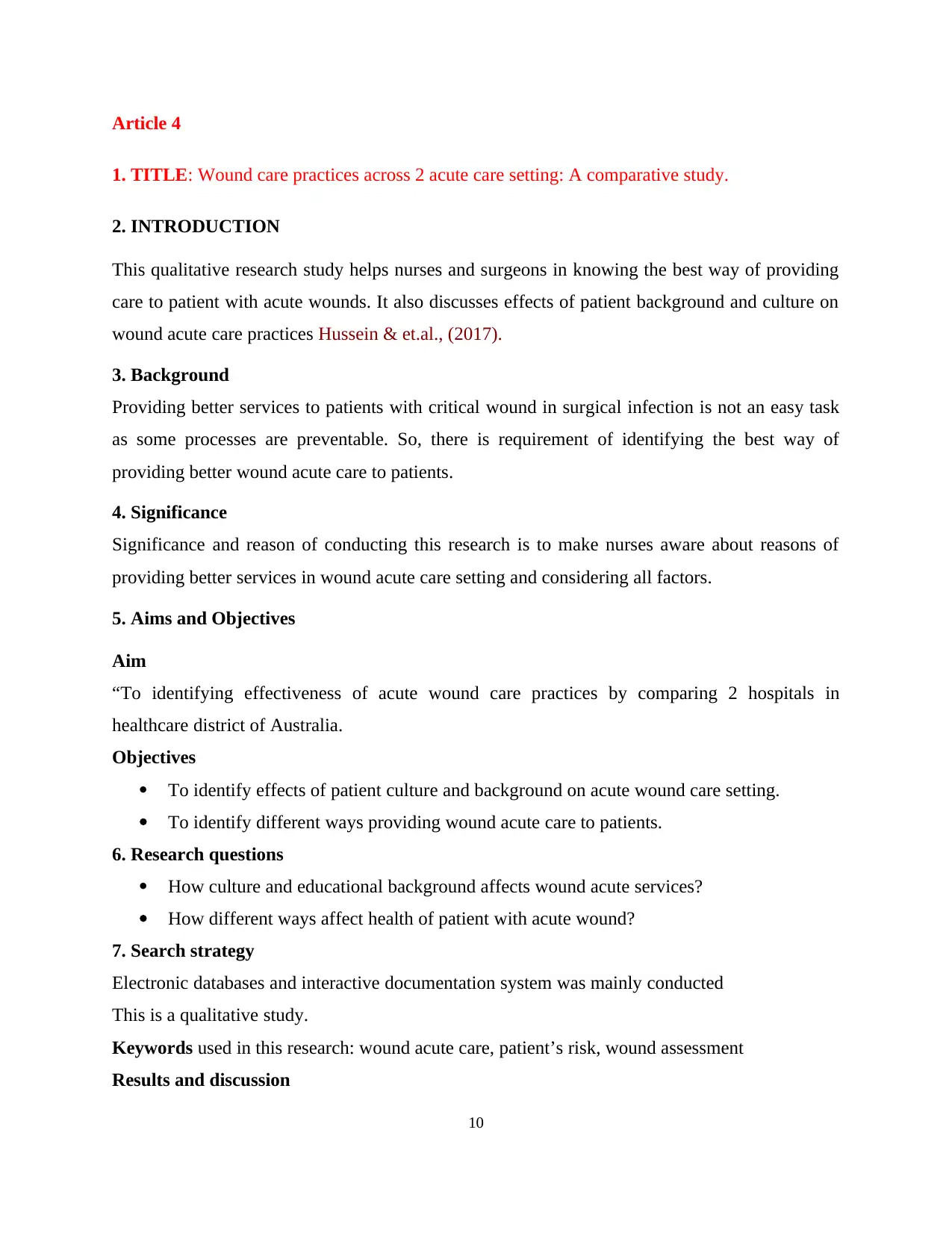
Article 4
1. TITLE: Wound care practices across 2 acute care setting: A comparative study.
2. INTRODUCTION
This qualitative research study helps nurses and surgeons in knowing the best way of providing
care to patient with acute wounds. It also discusses effects of patient background and culture on
wound acute care practices Hussein & et.al., (2017).
3. Background
Providing better services to patients with critical wound in surgical infection is not an easy task
as some processes are preventable. So, there is requirement of identifying the best way of
providing better wound acute care to patients.
4. Significance
Significance and reason of conducting this research is to make nurses aware about reasons of
providing better services in wound acute care setting and considering all factors.
5. Aims and Objectives
Aim
“To identifying effectiveness of acute wound care practices by comparing 2 hospitals in
healthcare district of Australia.
Objectives
To identify effects of patient culture and background on acute wound care setting.
To identify different ways providing wound acute care to patients.
6. Research questions
How culture and educational background affects wound acute services?
How different ways affect health of patient with acute wound?
7. Search strategy
Electronic databases and interactive documentation system was mainly conducted
This is a qualitative study.
Keywords used in this research: wound acute care, patient’s risk, wound assessment
Results and discussion
10
1. TITLE: Wound care practices across 2 acute care setting: A comparative study.
2. INTRODUCTION
This qualitative research study helps nurses and surgeons in knowing the best way of providing
care to patient with acute wounds. It also discusses effects of patient background and culture on
wound acute care practices Hussein & et.al., (2017).
3. Background
Providing better services to patients with critical wound in surgical infection is not an easy task
as some processes are preventable. So, there is requirement of identifying the best way of
providing better wound acute care to patients.
4. Significance
Significance and reason of conducting this research is to make nurses aware about reasons of
providing better services in wound acute care setting and considering all factors.
5. Aims and Objectives
Aim
“To identifying effectiveness of acute wound care practices by comparing 2 hospitals in
healthcare district of Australia.
Objectives
To identify effects of patient culture and background on acute wound care setting.
To identify different ways providing wound acute care to patients.
6. Research questions
How culture and educational background affects wound acute services?
How different ways affect health of patient with acute wound?
7. Search strategy
Electronic databases and interactive documentation system was mainly conducted
This is a qualitative study.
Keywords used in this research: wound acute care, patient’s risk, wound assessment
Results and discussion
10
⊘ This is a preview!⊘
Do you want full access?
Subscribe today to unlock all pages.

Trusted by 1+ million students worldwide
1 out of 18
Related Documents
Your All-in-One AI-Powered Toolkit for Academic Success.
+13062052269
info@desklib.com
Available 24*7 on WhatsApp / Email
![[object Object]](/_next/static/media/star-bottom.7253800d.svg)
Unlock your academic potential
Copyright © 2020–2025 A2Z Services. All Rights Reserved. Developed and managed by ZUCOL.




